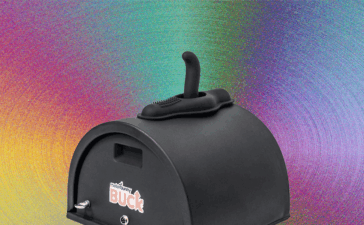Putting your goals in writing drastically increases your chances of achieving them. Goal setting templates make it easy to not only write them down, but also break them into actionable tasks and track progress towards reaching them.
Whether it’s a personal goal, professional goal, team goal, or a combination of all three, these templates will help you get off to an organized start.
monday.com: A quarterly objective goal setting template
monday.com is a project management platform that’s suitable for teams of all sizes. It’s perfect for goal setting because the collaborative elements help keep everyone on the same page and working towards common outcomes.
You can try it for free with up to two users, but most businesses will have to upgrade to a paid plan to get the most out of it.
It can also work well for solo users — if that’s you, you’ll likely be able to use it for free for a while. However, its range of collaboration and team-based features may feel overwhelming.
More on monday.com: monday.com review | monday.com vs Wrike | monday.com vs. Pipedrive.
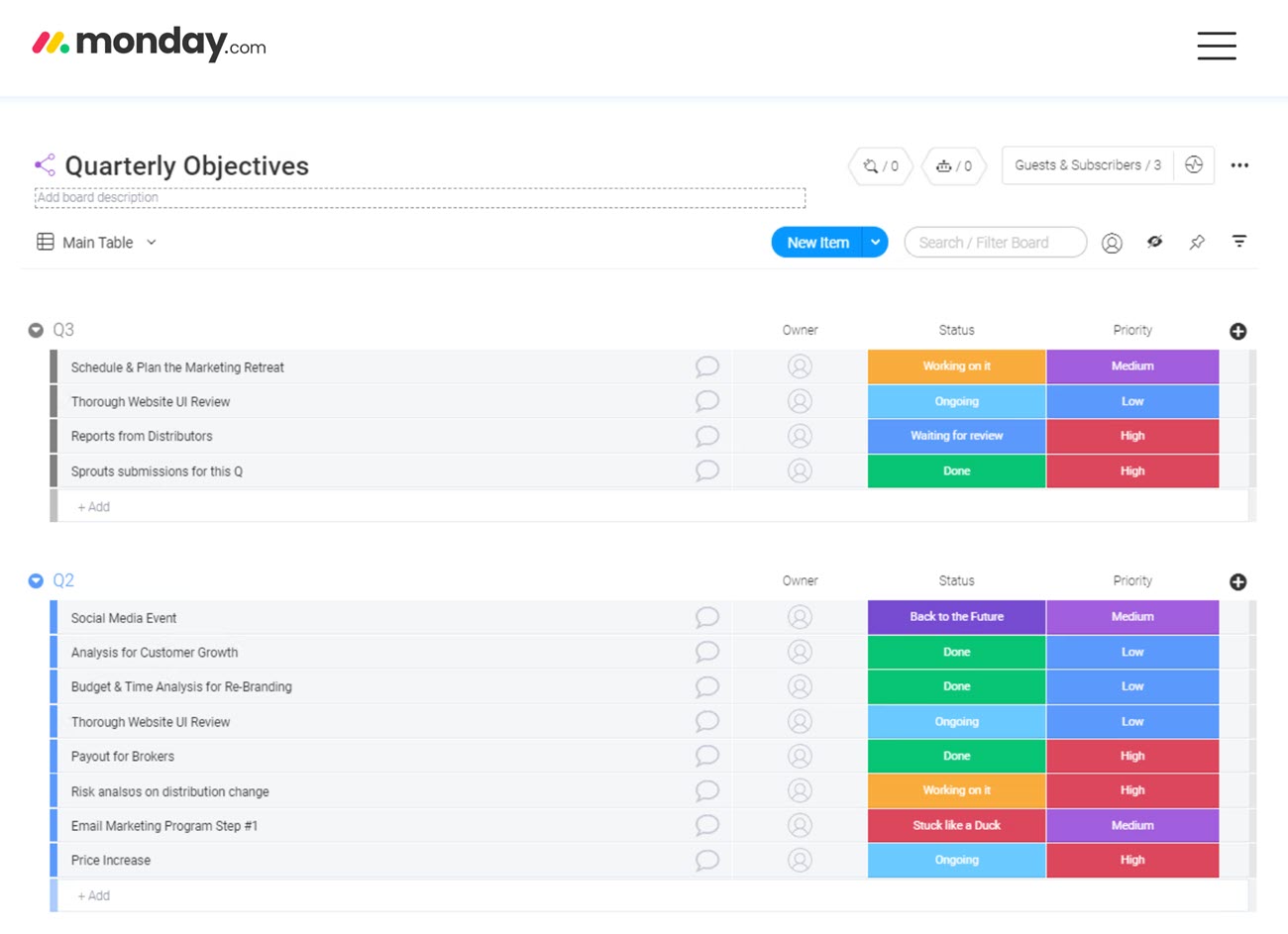
This goal-setting template is great for executives, managers, and team leaders. It’s set up for quarterly goal planning, so you can define key objectives at a high level and align them with longer-term business goals.
After identifying your goals, you can break them into smaller tasks and assign them to your team with due dates, priority levels, and real-time progress tracking.
The software’s flexible nature makes it easy to organize tasks however you’d like, set up automated notifications, and group items however it makes sense.
monday.com also has advanced features that help you track time, create automations to boost productivity, and even track your budget as it pertains to your team’s goals. Most of these features are on higher tiers though.
While this template is built for quarterly goal planning and tracking, you can adapt it to longer or shorter time frames if you’d like.
ClickUp: Goal setting templates for short and long-term planning
ClickUp is a feature-rich project management solution that’s powerful enough to run an entire business. The free plan is great for personal use, but the platform can also accommodate collaborative goals on a team or company-wide level.
ClickUp offers goal-setting templates for daily goals and quick wins, as well as big-picture goals for annual planning.
You can use either, or potentially both of these templates depending on what you need.
More on ClickUp: ClickUp Review | ClickUp vs Asana | ClickUp vs Notion.
Template 1: A simple template for daily goals and habits
This template works like a digital checklist you can reference on a daily basis. It’s perfect for things like daily meditations, drinking water, reading goals, daily journaling, and other quick wins or habits you’re working towards.
You can also add other short-term goals that may take longer than a day if you’d like.
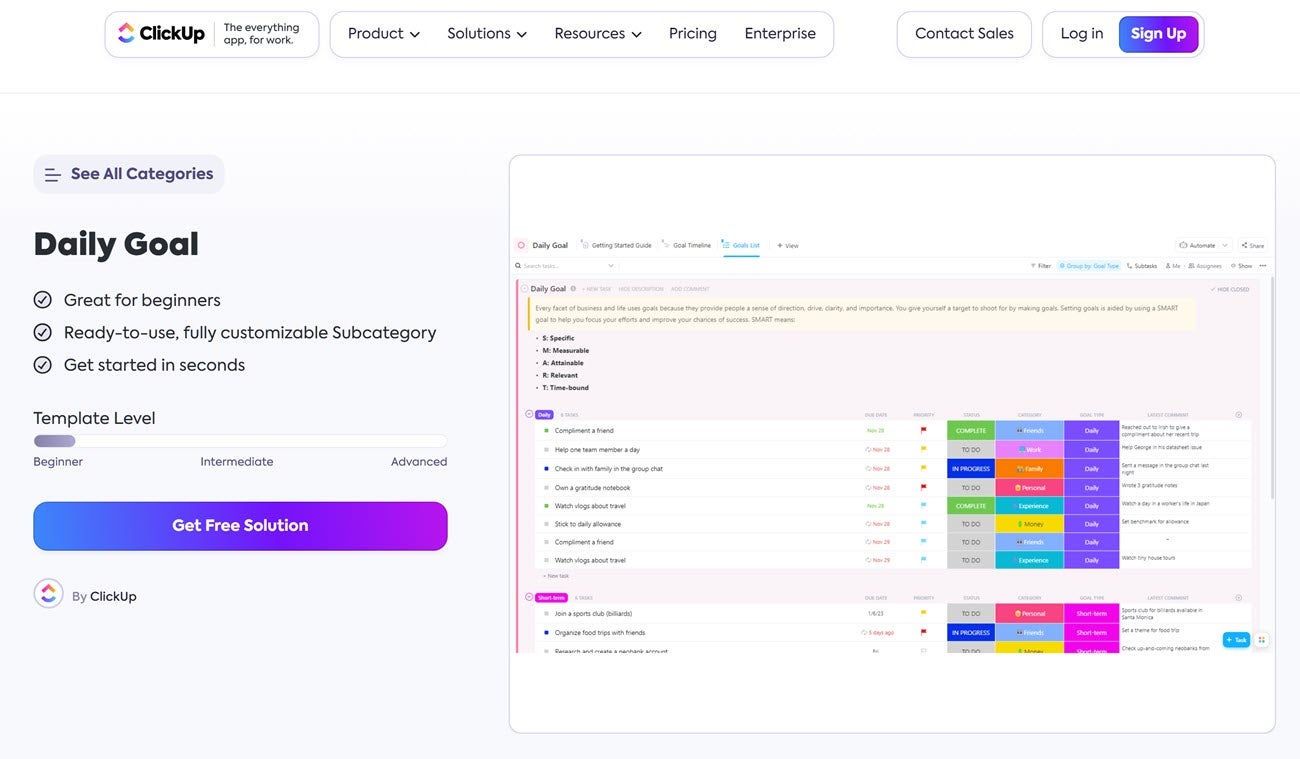
While this template was intended for personal use, it can be used just as well in a professional setting for developing soft skills, celebrating small wins, or encouraging steady growth.
Out of the box, it lets you categorize your goals, making it easy to organize by different areas of your life. For example, you may have categories for fitness, family, friends, mental health, money, personal, and professional.
These categories make it possible to filter, sort, and group your goals however you’d like. You can view all of them or focus on a specific area.
You can also give each goal a due date, status, and comment to leave notes for yourself.
Template 2: For tracking and managing long-term goals
If you’re looking to plan and manage goals longer term, this template is built for just that. Instead of quick daily wins, it’s set up to track high-level goals you want to achieve throughout the year.
Like the last template, this one is also built for personal use but can be adapted for use in a business setting as well.
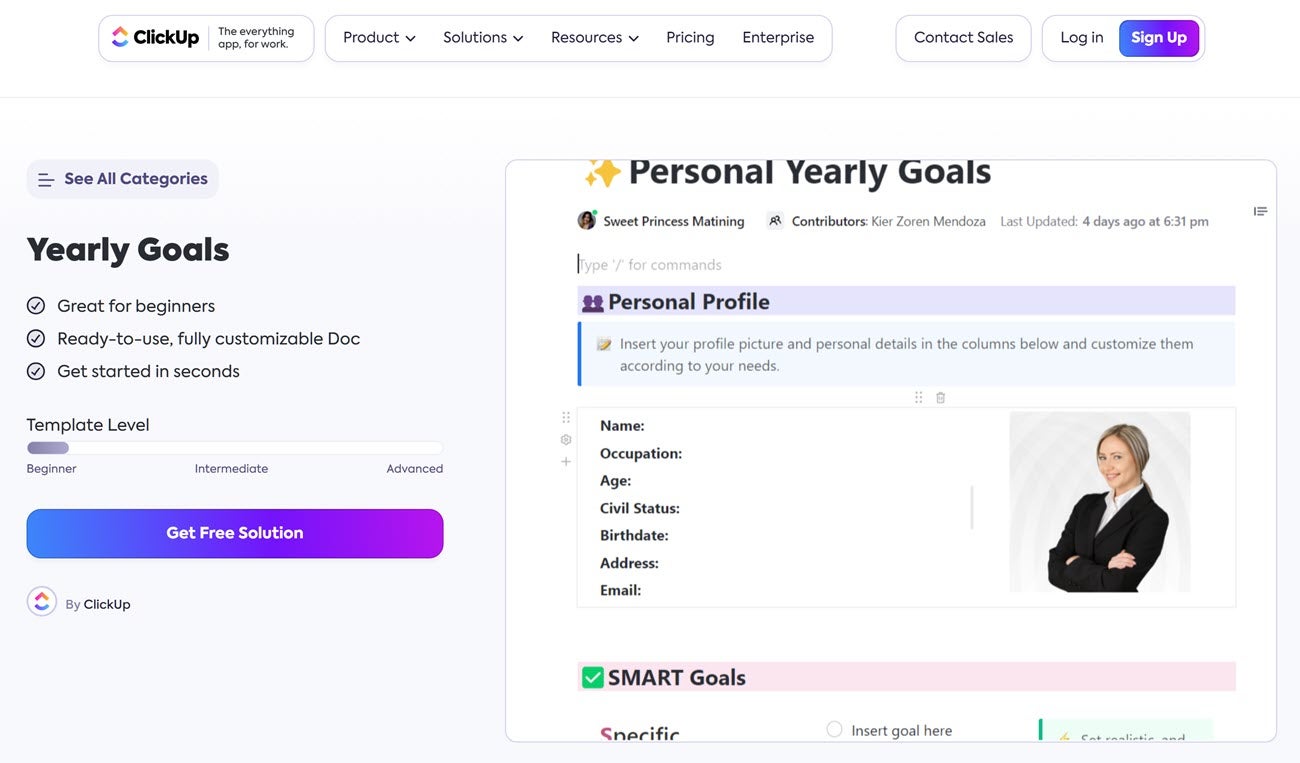
The best part about this template is that it makes it easy to break up a single long-term goal into three or more attainable tasks that help you move in the right direction. Rather than staring at something that feels intangible and too far off to matter, you can focus on taking actions that’ll directly help you get closer over time.
You’ll be able to prioritize goals, identify milestones, set due dates, and assign work to others if you’re using it as a team.
If new goals or opportunities present themselves along the way, you can easily add them to your list at any time.
It comes with a personal profile document where you can fill in your name, age, address, and other information. It’s a bit odd to have and you can delete it if you feel like it’s getting in your way.
Alternatively, you can tweak the document for vision planning or other more relevant activities if you’d like.
Wrike: A business goal setting template that focuses on OKRs
Wrike is a rigid yet powerful solution for businesses. It’s easy to set up and use but has a wide range of automation, collaboration, and team-based features that make it flexible enough as you scale.
It’s perfect for defining company goals and using OKRs (objectives and key results) to track progress and define success.
Unlike other project management tools that only offer free versions for individuals or a couple of people, Wrike’s free plan supports an unlimited number of users. It’s limited on features but lets you onboard your entire team at no cost.
More on Wrike: Wrike Review | Wrike vs Asana | Wrike vs Smartsheet.
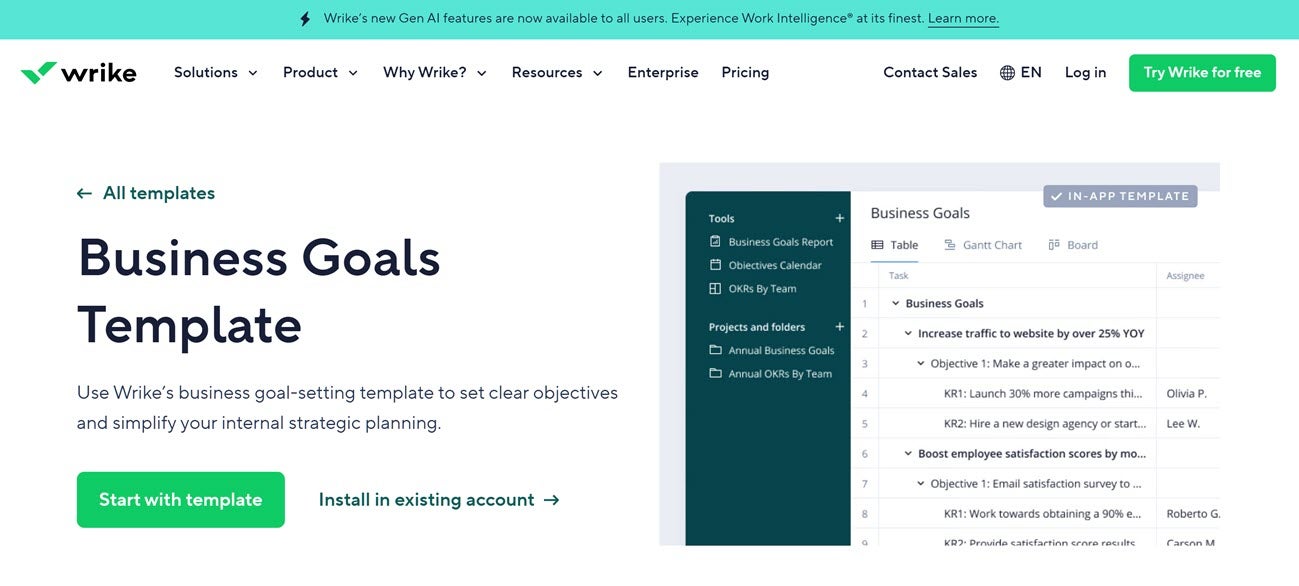
This template is versatile enough for department goals, team goals, company-wide goals, or any combination of the three. The way it’s set up, you’ll be able to tie all of these goals together with smaller goals feeding into high-level goals.
It’s great for taking a broad goal, like increasing website traffic or boosting employee engagement, and making it more specific by creating more manageable objectives.
You can add key results to each objective and then assign those responsibilities to people on your team. From there, everything ties up to your main goals, making it easy for everyone to keep an eye on progress over time.
There are also number- based milestones you can use.
For example, you may want to increase sales by 20% — you can set up milestones for 5%, 10%, and 15% to help you celebrate along the way.
Because of Wrike’s structured nature, you don’t have to do a ton of tweaking or thinking through how to set it up. It’s pretty much ready to go right out of the box.
Teamwork: A goal setting template for client-based businesses
Teamwork is an all-in-one project management platform that includes advanced features like budget planning, capacity management, and resource allocation. It also includes unlimited client users and granular permissions, making it great for client-based businesses.
There’s a limited free plan that supports teams of up to five users, but most businesses will need to upgrade to get the most out of it.
More on Teamwork: Teamwork Review | Teamwork vs monday.com | Teamwork Alternatives.
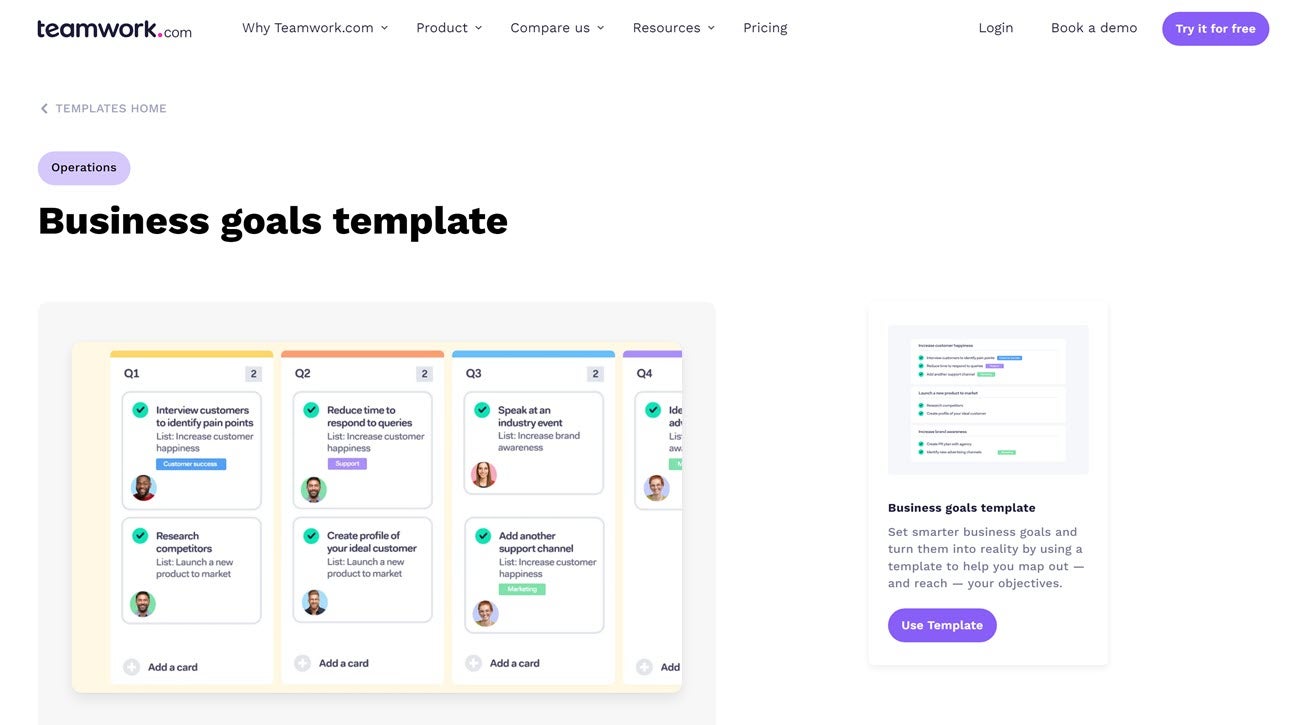
While Teamwork has plenty of advanced capabilities, this particular template is great if you want to keep goal management simple. It offers a clean and intuitive way to put goals in writing and ensure everyone is on the same page.
Each goal is a card that can have subtasks, assignees, owners, time tracking, and more. As your goals progress, you can move them to different columns.
Alternatively, you can group them by owner, category, or any other custom field you’d like.
If you upgrade to a premium plan, Teamwork’s capacity planning capabilities can help you plan without burning out your team. With it, you’ll be able to tell if someone’s overworked. You can also balance the workload by dragging and dropping tasks to another team member.
For agencies that need to collaborate with their clients, you can create separate workspaces for each client and manage their goals as well.
When set up correctly, you can roll all of your client goals up to your company-wide goals, giving you every detail you need at every level. Although it’s simple, it’s a great way to ensure every project — and your team or business — is on track.
Notion: An easy way to track personal goals for the year
Notion is an online productivity platform. It’s great for individuals and teams who like to build out their own digital workspaces. It can be as simple or complex as you need, making it a great all-around option for all sorts of use cases.
It’s easy to overcomplicate things, especially with a blank slate.
But making things too complicated often leads to a significant drop off in usage after the first few weeks. The simpler something is, the more likely you are to continue using it after the newness has worn off.
Because of that, my favorite Notion goal tracking template is incredibly simple.
More on Notion: Notion Review | Notion vs Asana | Notion vs OneNote.

The best part about this template is that it combines daily habit tracking with long-term goal planning in one place.
You can create a list of daily habits you want to stick to, and Notion will automatically create a new “habit card” for you each day. Each day, you can mark them off on a weekly or monthly calendar, and the template will keep track streaks for you.
This simple gamification is often all you need to stick with it until it becomes something you don’t have to think about doing.
Aside from that, you’ll be able to set goals for each quarter and break them down into tasks that you need to complete every month. You can get as granular as you’d like and even break it down into weeks or days if you prefer.
There’s also a space for taking notes — you can use this area to talk about what happened if you fell out of a habit so you know what went wrong in the future.
Although this template is designed for setting goals for the new year, you can use it any time with a few small tweaks.
Excel, Word, and PDF goal setting templates
Don’t want a new piece of software but feel like you’ve outgrown the notes app in your phone? A spreadsheet or document can be a strong upgrade, especially with the right template.
Template 1: A reusable SMART goals template
Smart goals are specific, measurable, achievable, relevant, and timely. You’re probably familiar with the concept, but you’d be surprised how often people miss one (or more) of these elements and feel frustrated when they show no visible progress.
Using this framework ensures you can actually move forward, track progress, and ride that positive momentum.
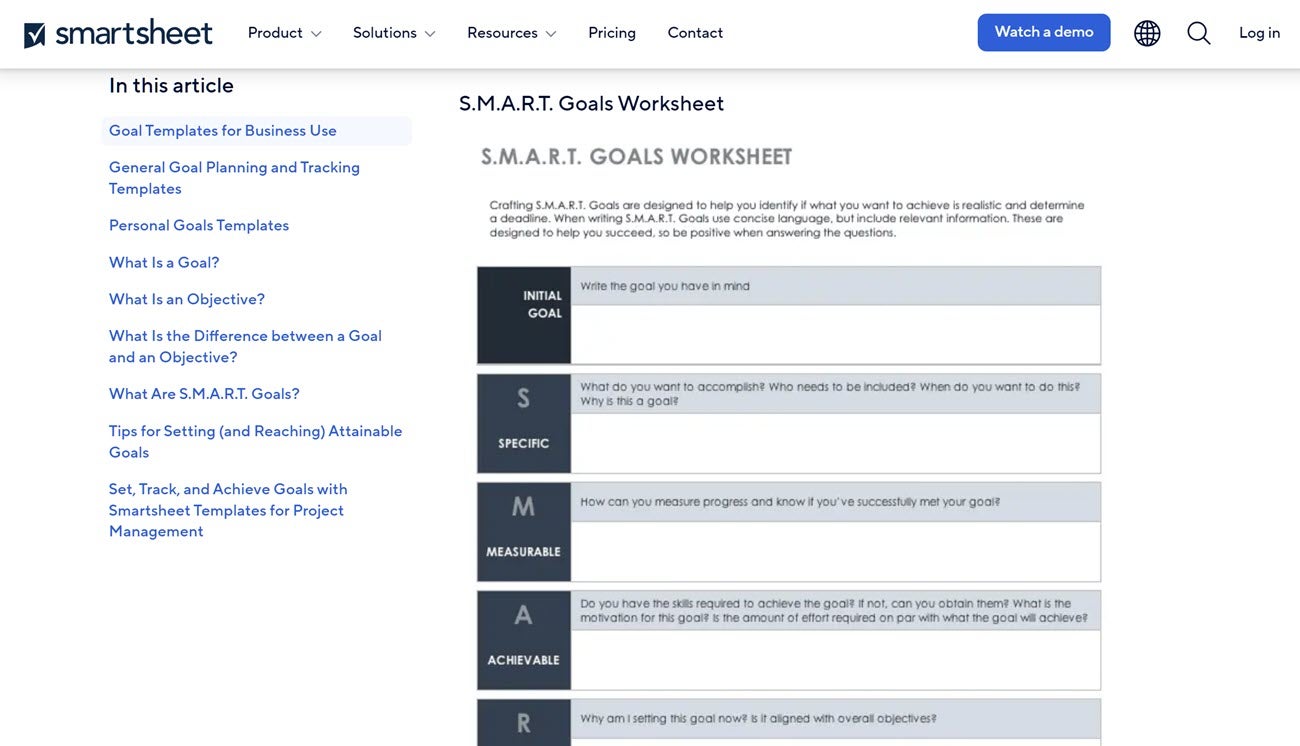
This template is available for free for Excel, Word, or PDF, so you can download and use it with whichever software you already have. You can also convert Excel or Word files to Google Sheets and Google Docs if needed.
Although simple, this template is versatile — it’s great for both individual and professional users.
It may feel cumbersome to fill out the entire page, but it forces you to clarify your objectives to set yourself up for success.
You can make as many copies of this worksheet as you need and print or fill them out online.
Template 2: An easy way for managers to set goals for their employees
This Smartsheet template is free to download as a Word or PDF file. It’s ideal for managers who want to manage goals for each of their employees. Unlike company-wide objectives, typical project management platforms don’t always translate to tracking goals for 20 or 30 people.
You also may not want everyone on the team to be able to see each others’ goals. This alternative is simple, yet just as effective if you need an element of privacy.
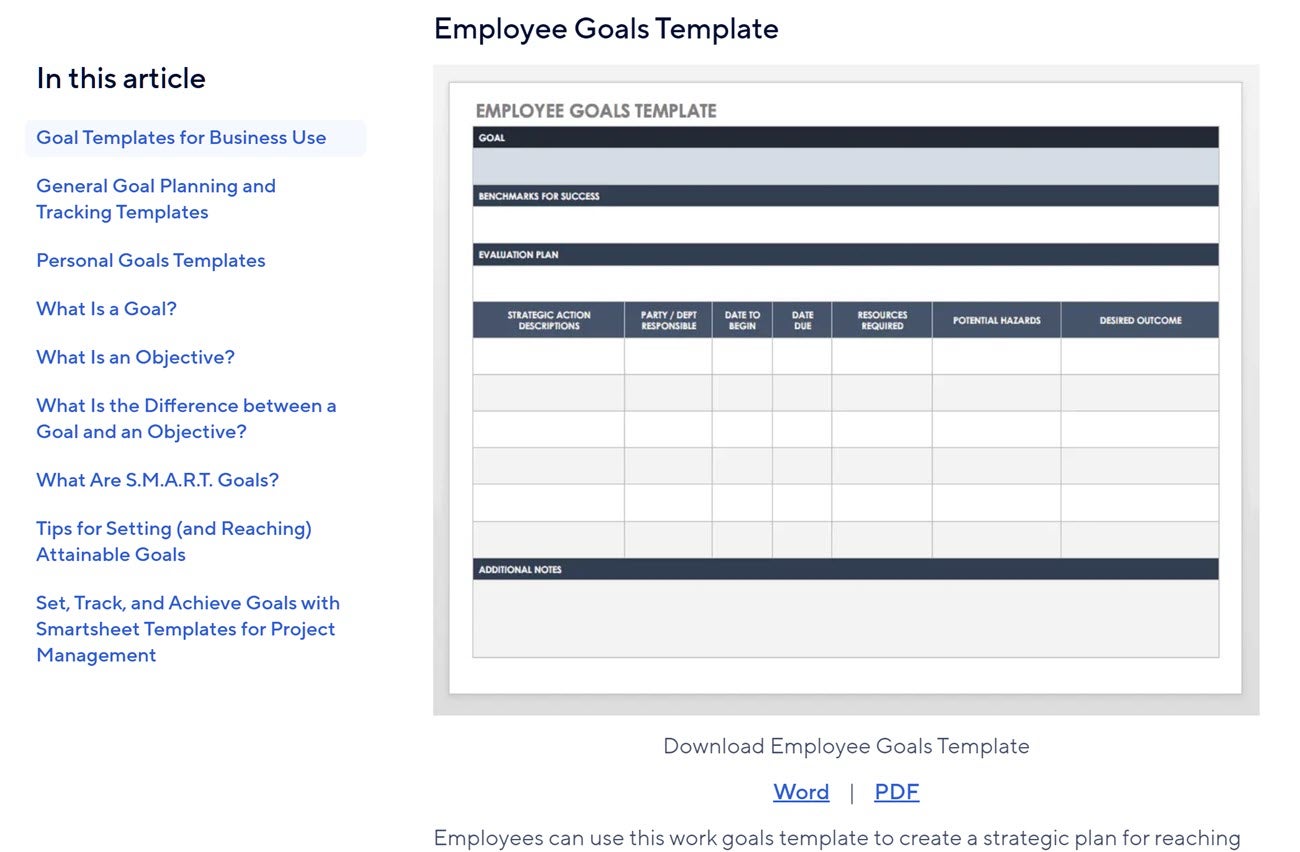
The template is straightforward and concise, keeping each employee’s goals, action plan, and notes to a single page. While you will have to make a copy for every employee, it ensures nobody else can see what you write down.
It’s printer-friendly if you handle goals during quarterly or annual reviews that take place in person.
You can use this template for performance goals (like sales or customer satisfaction) or soft skills (like leadership and communication). It also gives each employee a place to refer back to if they ever feel lost or unsure.
Together, you’ll be able to come up with an action plan, set due dates, get ahead of roadblocks, and agree on desired outcomes so you’re always on the same page.
How to choose the right goal setting template
It can often feel daunting to pick a template and get started. However, the longer you bounce around, the longer it will take to start working towards your goals.
I strongly encourage you to choose the simplest option that works for you. There’s no need to complicate it. Whether that’s the notes section on your phone, a blank Google Doc, a piece of paper in a notebook, or one of these templates, the important thing is to get started.
If you’re still feeling unsure, here are a few considerations to keep in mind:
- Personal vs business goals — Are you wanting to track personal goals (like losing 15 pounds) or business goals (like increasing lead volume by 10%)?
- Short vs long-term goals — Short-term goal planners are great for quick wins and daily actions, whereas quarterly or annual goal-setting templates typically let you dream big and work backwards to an achievable to-do list.
- Individual vs team goals — Some templates are clearly designed for solo users, while others have a collaborative element for teams working toward common goals.
- Online vs offline — Do you want to use pen and paper or fill everything out online? Do you need structure (like a table, spreadsheet, or Kanban board) or do you prefer writing everything down and organizing from there?
At the end of the day, most goals have desired outcomes, plans of action, and due dates. This is true even if they’re for individuals, teams, businesses, or somewhere in the middle.
As long as you find something you enjoy using, you should be good to go.
Best practices for setting goals (so you can actually achieve them)
Most templates help you get organized and track progress. A few help you actually set goals, but for the most part, that’s up to you. Here are some best practices to keep in mind:
- Quality over quantity.
- Have a clear definition of success.
- Avoid broad goals that can’t be quantified.
- Set deadlines to hold yourself accountable.
- Be flexible and give yourself grace for missed deadlines.
- Break large goals into milestones that don’t feel as intimidating.
- Avoid an all-or-none mentality — missing one goal shouldn’t derail everything else.
- Celebrate wins and successes.
No matter what, it’s important to stick to something rather than jumping around. In the past, I’ve forced department heads to set quarterly goals they’re not allowed to change until the next quarter.
If they don’t meet them, that’s okay as long as they understand why and how to adjust the goal to make it more achievable or aligned with our direction.
You don’t have to go that extreme, but staying focused is key.


